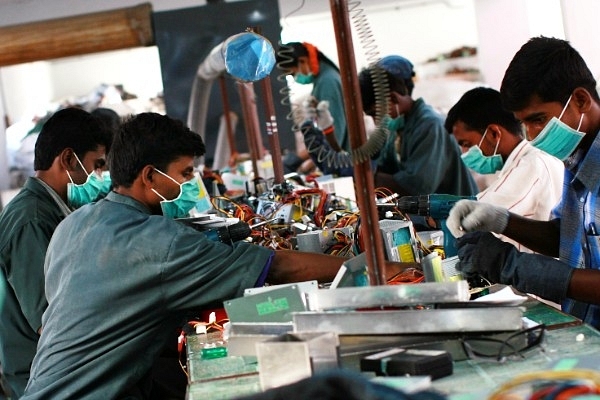Business
Labour Laws – Keeping Both The Worker And The Employer Down
- An open labour market is integral to development and further prosperity. The current labour market artificially limits the ability of both labourers and employers.
- The rationalisation and codification of the labour laws is on the whole beneficial to the majority of the labourers and to the employers is being roadblocked by ‘organised labour’ to promote their vested interests.

Factory workers in India (Uriel Sinai/Getty Images)
The biggest nightmare that establishments in India face is compliance with the myriad and confusing labour law statutes, rules, regulations and orders. Just look at the amount of legislations that have been enacted by the union government for the protection of the interests of the labourers. This is then multiplied by the legislations and rules enacted by individual states, and further complicated by rules made under central statutes by the states.
Most of these legislations are archaic, but still enforced. Many of their provisions and requirements overlap, yet exist as distinct legislations with distinct requirements, creating unnecessary hurdles for small establishments. In 2017, the Union Ministry of Labour undertook a small reform when it rationalised the requirements under three statutes, finding that 36 forms under them had redundant or overlapping fields.And that is just a drop in the ocean of the red tape that industries face to hire labour.
An open labour market is integral to development and further prosperity. The current labour market artificially limits the ability of both labourers and employers. The constraints on labour also makes the formalisation of the economy harder. Since the compliance cost follow labour laws that have been enacted are so high, it would be cheaper for an establishment to keep labourers of the books or to bribe the inspecting authority to look the other way. This affects the laborers adversely as well.
A system more equitable for employers and employees will make the law easier to follow, and will make the general condition of the labor community much better. Trade unions oppose any sort of liberalisation of the labour market for their own short term political prospects.
The central government, in a positive move, extended fixed term employment to all sectors. As this report puts it correctly, ‘fixed term employment’ is “ defined as a workman who is employed on a contractual basis for a fixed period. Thus the services of the workman will be automatically terminated as a result of non-renewal of the contract between the employer and the workman concerned”.
Trade unions of course, opposed this move. This extension could recast the entire labour market in the country, and be the boost that could further enhance the growth of industries. There are more reforms in the pipeline, including the much needed codification and rationalisation of the labour laws. This can enhance the ability of industries to expand, after all, the biggest barrier for them is the compliance cost of following the myriad labour legislation.
A single legislation and set of rules that companies and businesses can be easily referred to, and be depended upon can be just the sort of move that India’s Micro, Small and Medium Enterprises(MSME) needs. Moreover, the enactment of these codes prove an attractive option to the Modi Government, as it can boost Job growth. The opposition to this of course, is yet again the trade unions.
The rationalisation and codification of the labour laws is on the whole beneficial to the majority of the labourers and to the employers is being roadblocked by ‘organised labour’ to promote their vested interests. The Modi government will do well to push through these much needed reforms. They have the potential to be the third major ‘reset’ or disruption of the economy after demonetisation and goods and services tax(GST). With the gross domestic product growth hitting a two year high of 8.2 per cent, labour reforms could provide further impetus for growth especially in the manufacturing sector. It just might be the bang that the economy needs at this point.
Support Swarajya's 50 Ground Reports Project & Sponsor A Story
Every general election Swarajya does a 50 ground reports project.
Aimed only at serious readers and those who appreciate the nuances of political undercurrents, the project provides a sense of India's electoral landscape. As you know, these reports are produced after considerable investment of travel, time and effort on the ground.
This time too we've kicked off the project in style and have covered over 30 constituencies already. If you're someone who appreciates such work and have enjoyed our coverage please consider sponsoring a ground report for just Rs 2999 to Rs 19,999 - it goes a long way in helping us produce more quality reportage.
You can also back this project by becoming a subscriber for as little as Rs 999 - so do click on this links and choose a plan that suits you and back us.
Click below to contribute.
Latest